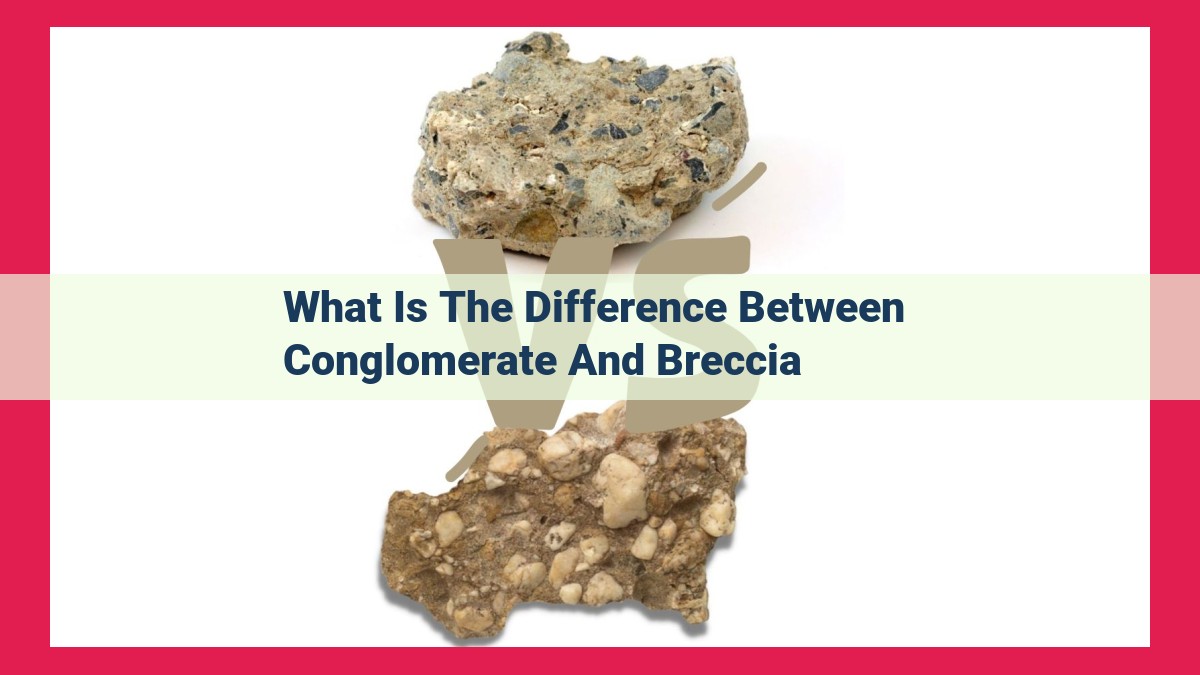Sedimentary Rocks: Understanding Conglomerate Vs. Breccia By Clast Shape

Conglomerate and breccia, sedimentary rocks composed of coarse fragments, differ primarily in clast shape: conglomerate clasts are rounded due to transport and abrasion, while breccia clasts are angular, representing nearby rock fragments with minimal transport. Conglomerates exhibit bedding and sorting, while breccias often lack these features. Understanding these distinctions aids in deciphering geological processes and environments.
Conglomerate and Breccia: The Tale of Two Sedimentary Rocks
In the realm of geology, sedimentary rocks narrate the captivating tales of ancient environments. Among these stories, *conglomerate* and *breccia* hold a prominent place, captivating us with their intriguing compositions and the secrets they reveal about Earth’s history.
These remarkable rocks are composed of coarse-grained fragments, remnants of pre-existing rocks that have been shattered and transported by powerful natural forces. However, despite their shared origins, conglomerate and breccia stand apart, each with a unique tale to tell.
At the heart of their distinction lies the shape and rounding of their clasts. Conglomerate clasts, like smooth, rounded pebbles, have undergone a journey of abrasion and tumbling, transforming them from sharp-edged fragments into gentle, water-worn treasures. In contrast, breccia clasts remain angular, preserving the jagged edges of their former existence, hinting at a more tumultuous past.
Conglomerate: A Tale of Rounded Fragments
Imagine yourself on a beach, surrounded by pebbles and stones, each one a testament to the relentless waves that have shaped them over time. Conglomerate, a sedimentary rock, is much like these weathered pebbles, only on a grander scale.
Conglomerate is a coarse-grained rock, made up of rounded fragments called clasts. These clasts can vary in size from pebbles to boulders, and they are typically made of quartz, limestone, sandstone, or other hard rocks.
The distinctive rounded shape of conglomerate clasts is no accident. It is the result of a journey they take, tumbling along rivers and beaches, their sharp edges gradually smoothed by the abrasive forces of water and colliding with other clasts. This process is known as abrasion.
As the clasts continue their voyage, they become coated in a finer material called a matrix. This matrix can be made of sand, silt, or clay, and it helps to bind the clasts together.
Related Concepts
Conglomerate is not just a collection of rounded clasts. It is a complex rock with a rich geological story to tell. Here are some related concepts that help us understand its formation and significance:
- Clasts: The individual fragments that make up conglomerate.
- Matrix: The finer material that binds the clasts together.
- Rounding: The process by which clasts lose their sharp edges.
- Sorting: The degree to which clasts are arranged by size.
- Bedding: Layers of sediment that make up conglomerate.
- Texture: The overall appearance of conglomerate, determined by the size, shape, and arrangement of its clasts.
- Composition: The mineralogical makeup of conglomerate.
- Age: The geological period in which conglomerate formed.
Breccia: The Rock of Broken Pieces
In the realm of sedimentary rocks, breccia stands out with its unique character. Unlike its cousin conglomerate, breccia tells a tale of nearby rock fragments, broken and haphazardly cemented together.
Angular Clasts: A Distinctive Trait
The most striking feature of breccia lies in its angular clasts. These fragments, unlike the rounded pebbles in conglomerate, lack the gentle touch of water’s abrasion. Instead, they remain sharp-edged and jagged, remnants of their violent past.
Local Origins: A Testament to Proximity
Breccia clasts often originate from nearby rocks, indicating minimal transport. They represent a mosaic of the surrounding geological landscape, capturing fragments of the local environment. This tells us that breccia forms close to its source, bearing witness to dramatic events that shattered rocks and left them scattered.
Related Concepts: A Deeper Dive
Just like conglomerate, breccia involves a host of related concepts:
- Clasts: The fragments that make up breccia.
- Matrix: The material that fills the spaces between clasts.
- Rounding: The absence of rounding, defining the angular nature of breccia clasts.
- Sorting: The lack of sorting, as breccia clasts are typically jumbled together.
- Bedding: The absence of distinct layers, unlike the organized strata found in conglomerate.
- Texture: The coarse-grained, angular texture of breccia.
- Composition: The diverse composition of breccia clasts, reflecting the rocks in the nearby source area.
- Age: Breccia can form in various geological periods, providing insights into the past.
Key Differences: Conglomerate vs. Breccia
When it comes to sedimentary rocks composed of coarse-grained rock fragments, conglomerate and breccia stand out as two distinct types. While they share similarities, their differences are crucial in understanding their geological origins.
Shape and Rounding of Clasts:
The most striking difference between conglomerate and breccia lies in the shape of their constituent fragments, known as clasts. Conglomerate clasts are rounded and smooth, having undergone extensive transport and abrasion during their journey in rivers, glaciers, or coastal environments. In contrast, breccia clasts are angular and jagged, indicating minimal transport and breakage of nearby rocks.
Presence or Absence of Bedding and Sorting:
Conglomerate often exhibits bedding, or distinct layers of sediments, and sorting, where clasts of similar size and shape tend to be grouped together. This organization reflects the natural processes of deposition and erosion in water bodies. Breccia, on the other hand, lacks these features due to its limited transport and depositional environment.
Examples:
To solidify these differences, let’s consider two examples. A conglomerate might be found along a riverbed, where the rounded pebbles have been shaped by the relentless flow of water. Conversely, a breccia could be present in the vicinity of a volcanic eruption, where rocks have been shattered and cemented together without significant transport.
By understanding these key differences, we gain insights into the geological processes and environments that gave rise to these fascinating sedimentary rocks. Conglomerates tell tales of flowing rivers and ancient coastlines, while breccias hint at volcanic eruptions and tectonic events that shaped our planet’s history.